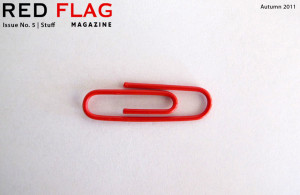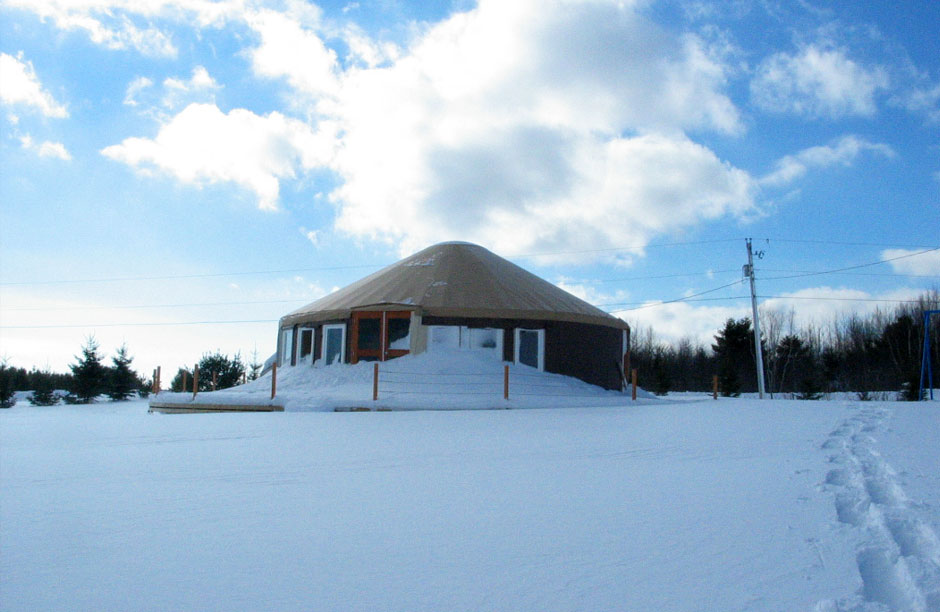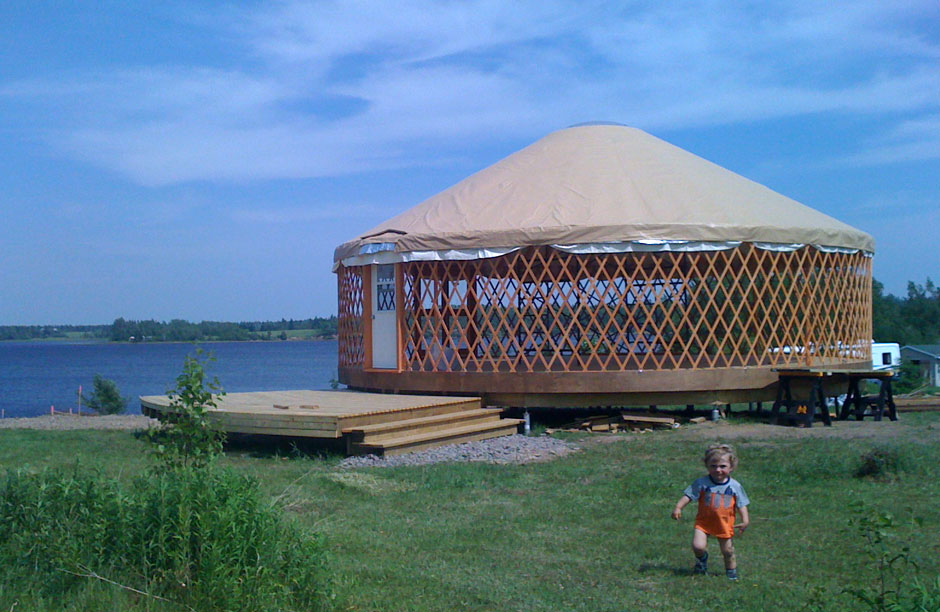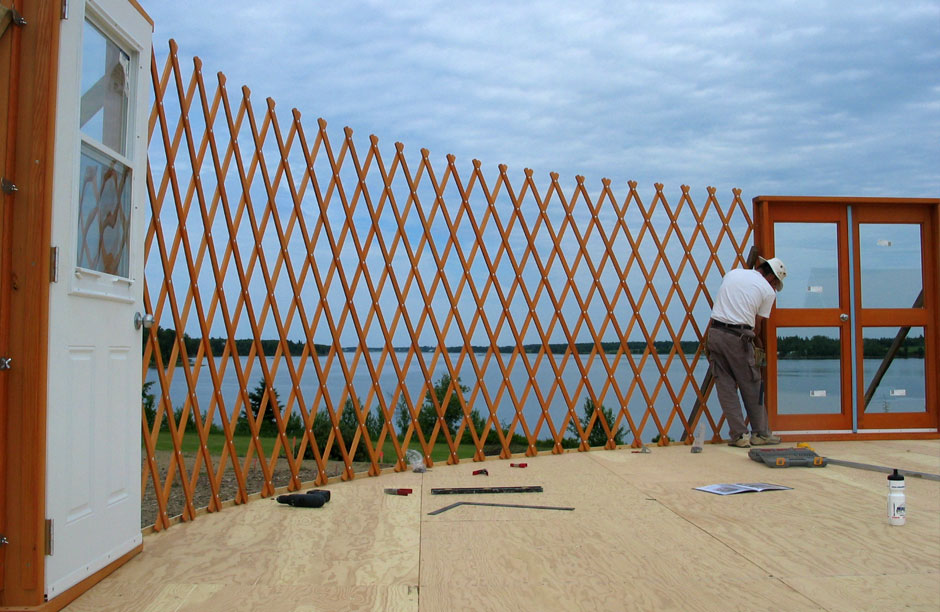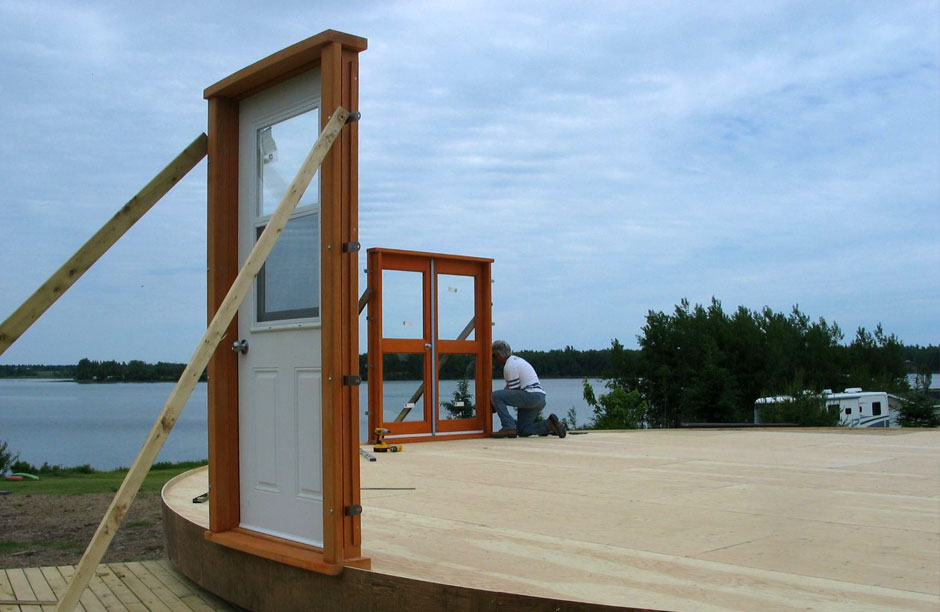Door’s First
By Jason Hamilton
Though I didn’t read the installation instructions on the plane I had spent time in previous months reading the manual and watching quick videos on Youtube of how to construct the yurt. I felt confident in my knowledge that I could answer most questions or concerns pertaining to the erection process (insert joke here.)
And of course, now that we had graduated from the platform which passersby took in quizzically, to an actual subfloor, the curious eyes that had once only cruised past the site were now starting to slow down to take a closer look at the project.
Those eyes now started to take their time to study the intrigue that was unfolding before them. What they would find was two men crouched in the middle of the floor, measuring tapes extended, forming a triangle. And then, after pausing, scratching heads, those tapes would be picked up, moved and reformed in the exact same scenario.
Dipping into an ancient formula to find our true center and our subsequent twelve o’clock and nine o’clock door positions (Pie and Pythagorean Theorem respectively) we paused for a moment before making our cuts out of the rim of the floor.
“We’ve double checked this, and these are our absolute door positions?” Chris asked me. I nodded an affirmative.
“And we have to be as accurate as we possibly can be?” Chris questioned again.
“Yes, they even have it in bold. As a matter of fact, I think it’s the only thing in here that they mention where they do ask for precision.”
“How come only dat Jase?” Fern asked.
“Good question…” I say flipping a few more pages but quickly losing patience with trying to find a reason.
“I don’t know, that’s just what it says.” I return.
And so, without further delay, the pieces were cut, our doors were leveled, our weathering was applied and the doors were installed.
The doors that is…first.
To this point we’d all been good sports and allowed our minds to accept we weren’t building a ‘traditional’ home, but when only the doors were standing on the floor, above all else, the only thing we could say for sure was, “What must these Newfie contractor’s be doing!?!”
That was a passage from my blog “The Yurt Files” – a chronicle of my experience planning, building and living in a yurt with my family in New Brunswick. A yurt?, you say. How did I arrive at such a decision? And perhaps you’re wondering – what exactly is a yurt?
Even before the pillars of the American financial community started to crumble we’d been thinking about making a move. As the United States real estate market imploded and institutions lined up for bail-out money it appeared as though the long, slippery road of collapse we’d been warned about was taking shape. Considering the hotly contested Kyoto protocol over climate change and the growing dangers of ‘peak oil’, my Spidey senses were trained for any fall-out associated with those tensions. The real estate meltdown brought everything into sharp focus.
Depending on how the market fluctuated we either made a really smart move or a very costly one when we bought our Toronto home in 2004. Four years after that purchase the balance on our mortgage was exactly the same. Without a buyer in the marketplace who believed our home was worth substantially more than we paid for it our ‘investment’ could end up being an Albatross. As word of ‘panic’ and ‘desperation’ spread south of the border it looked like our window of opportunity to take advantage of the Toronto housing situation was closing. Prices were holding steady, but how long would it last? More critically, if we sold our home we would still need a place to live and a community in which to make a living.
Long before parenthood and home ownership, my wife Sylvie and I fell in love with a piece of property we purchased on a tidal river that a Migmaw legend had termed the ‘River of Fire’. As the financial disaster worsened the casual whims of what to do on our land on the Richibucto River on the East Coast of the province of New Brunswick were starting to get serious. But what would we build? A Bunkie? Park a camper trailer?
What could we do that would give us room to grow as a family, was ecologically neutral, while still providing the comforts of home while not costing a small fortune to build? The answer came in the form of a yurt.
The challenge for archaeologists to accurately date the official origins of the yurt rests in the nature of the structure itself and the people who used them: nomadic hunter gatherers tread lightly on the land and don’t rest long enough in one place to declare their presence. Evidence exists that technology to build a yurt was developed by the 5th century BC. While legends date the origin of the yurt even further back in history. We often underestimate the ingenuity of our ancestry and it’s entirely probable that a round, transportable shelter may have accompanied the hunters who walked across the land bridge to North America at the end of the last ice age. (Unfortunately any proof of that theory lies in state at the bottom of the Bering Sea.)
In the ancient world of the nomadic hunter-gather, from the Asian steppe’s (yurt) to the North American prairie (tipi) and even beyond into the arctic (igloo), the shelter begins as a circle on the ground. The adaptation of that structure then lends itself to many differing factors: culture, available materials and prosperity (animal hides, furs). Hence, in Asia, the raised round dwelling developed along two differing lines: The Turkish ‘uy’ and the Mongolian ‘ger’ (that, when compared to Native North American housing looks similar to the Migmaw wigwam.)
The yurt was popularized by Mongolian tribes and spread long and far in the wake of the empire left by Genghis Khan. Its style, the round, high walls that reach to a domed ceiling in the middle of the roof, inspired the manufacturer of our product, but incredulously is still in use in Mongolia today!
Architecturally, a round structure is extremely durable and strong. Unlike square and angled buildings, a round structure allows the wind and elements to pass around the dwelling without ‘catching’ it. Inside, the curvature of the walls allows heat to disperse evenly throughout the yurt.
But what I really noticed from building my own yurt and living in it for a period of time is the ancient culture’s that had a critical grasp of the flow of energy couldn’t be more timeless. The layer of protection from the outside elements is minimal enough that you always feel a part of the greater world around you and yet it’s reassuring and cozy. The peaked dome creates an expanse of space yet feels intimate. The living space we created wasn’t huge yet we always seemed to have everything we needed.
Resting on the deck, the violent red hues of a brilliant ‘River of Fire’ sunrise arrests my spirit. Here, no matter where the energy flows, inside or out, I’ve found my peace of mind housed in the thinnest of fabrics that gives me shelter but never lets me forget the impact of the greater world around me.
Of course, the experience came at a cost of several bumps along the way. I chronicled the mercurial experience step by step in the “Yurt Files” – the contents of which have now become the foundation of a book titled “Life, The Yurt and Everything Else”, which I expect to complete by next fall. We also no longer live full-time in our yurt. After spending a few months looking for jobs in the fields we truly wanted to work in my wife and I went for a more secure route and used the money from the sale of our Toronto house to put a down payment on another one.
Now I look back and realize why it was so important to build the “doors first”. When stepping from one life to another or back into nature – the place we derived – the door is the space where those two worlds meet. For that brief phase when just the door stood erect on the foundation of our yurt it felt really great to live in a world without walls.
